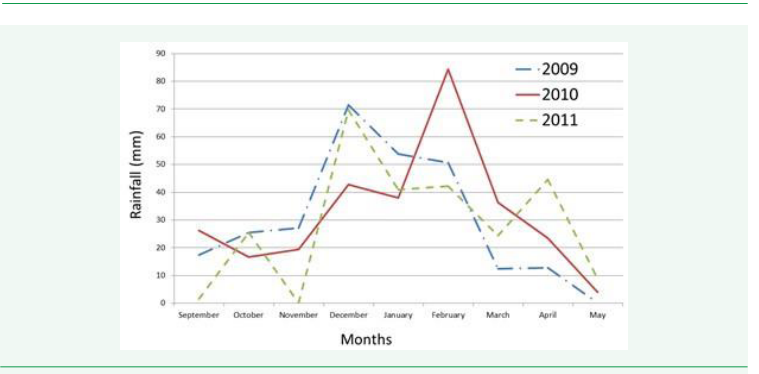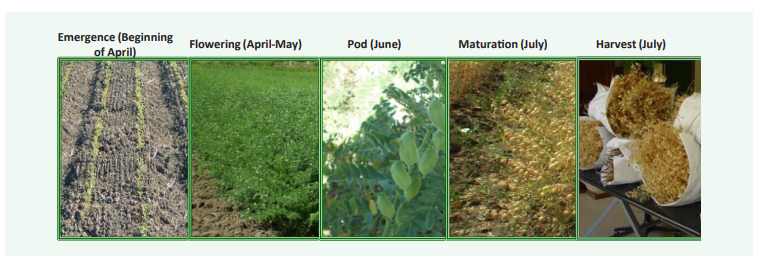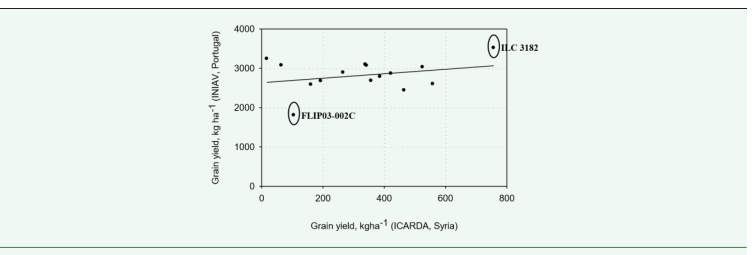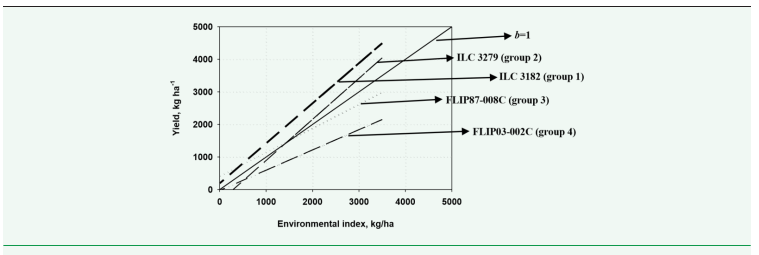Adaptation and Yield Stability for chickpea genotypes to the Mediterranean basin
- 1. INIAV, Elvas, Apartado 6, 7351-901 Elvas, Portugal
- 2. CARDA, Aleppo, Syria (actually - Wheat Value Chain Advisor & Director Scaling/3 Commercialization Nutrition Agri Future at Harvest Plus Pakistan)
- 3. UCIBIO Applied Molecular Biosciences Unit, Department of Life Sciences, NOVA School of Science and Technology, Universidade NOVA de Lisboa, 2829-516 Caparica, Portugal
- 4. Associate Laboratory i4HB Institute for Health and Bioeconomy, NOVA School of Science and Technology, Universidade NOVA de Lisboa, 2829-516 Caparica, Portugal
- 5. Associate Laboratory i4HB Institute for Health and Bioeconomy, NOVA School of Science and Technology, Universidade NOVA de Lisboa, 2829-516 Caparica, Portugal
Abstract
In Mediterranean traditional agricultural systems, chickpea (Cicer arietinum L.), the third most important pulse crop in the world, is a spring crop and yield is extremely affected by soil water availability during the reproductive phase. As a consequence, there is a need to develop chickpea germplasm with resistance to drought and other abiotic stresses as high temperatures. Chickpea requires around 150 days from sowing to maturity, the actual duration of the development cycle being water and temperature dependent. Chickpea can be cultivated in the range of mean daily air temperatures of 20-30ºC, but high temperatures can limit production seriously. Similarly, chickpea yield may decrease substantially with increased frequency of drought. The present investigation was carried out to study stability for seed yield and its components in 15 chickpea genetically diverse genotypes (13 from ICARDA, Syria and 2 from INIAV, Elvas, Portugal), using a randomized complete block design. Trials were conducted during three years under rainfed conditions in Portugal and Syria, using a late sowing date to naturally expose the plants to drought and heat stress. Our approach revealed a high variability in the yield response among genotypes and regions. Genotype × Environment interaction (GxE) was observed in all experiments and cross-over GxE interaction between top-yielding and low yielding cultivars showed that greater productive potentials in Portugal. Due to higher and more adequate distribution of rainfall, the yield potential is higher in Portugal than in Syria. In general, genotypes that fasten their development cycle showed higher grain yield, especially in dry years. The three years assays across two sites showed four groups of genotypes: 1) genotypes with high adaptation to distinct environments; 2) genotypes adapted to favourable conditions, but with bad performance under adverse conditions; 3); genotypes with very good adaptation for poor environments and 4) genotypes with no adaptation potential. Two genotypes, ILC 3182 and FLIP03-145C, stand out by their high yield in the two regions and three years, including under water stress conditions.
Keywords
GxE interaction, Drought, Heat stress, Adaptation potential
Citation
Duarte I, Imtiaz M, Pinheiro C, Simões N, Chaves M. (2023) Adaptation and Yield Stability for chickpea genotypes to the Mediterranean basin. Int J Plant Biol Res 11(1): 1134.
INTRODUCTION
Chickpea (Cicer arietinum L.) is an indeterminate plant, traditionally in the Mediterranean regions. Grain yields under rainfed conditions are normally low even though it is considered one of the most drought tolerant food legumes [1]. Traditionally, chickpea is sown in the early spring and yields rarely overpass 500 kg ha-1, while sowing during November/December yields can be improved up to 3000 kg ha-1 because plants develop more biomass, flowers and pods. However, winter sowing plants may have problems during late spring due to the lack of rain, since higher biomass means more transpiration leading to a stronger crop stress. Drought is one of the most important factors limiting productivity of rainfed chickpea in the Mediterranean environments, a direct relationship between average grain yields and total rainfall and air temperature being described [2,3].
Crop models usually fail to predict yield under the Mediterranean climate pattern [4], where intermittent drought is common. Because chickpea is an indeterminate growth, the pattern of water distribution along chickpea lifecycle is relevant. The occurrence of high precipitation after a long dry period promotes flower dropping, pod abortion with a consequent decrease in grain yield [5]. However, supplemental irrigation, generally applied between flowering and the beginning of seed growth, can significantly improve yield [6,7]. In addition, high temperatures that commonly occur in parallel to water deficits, lead to acceleration of the growth cycle and further reduce yield [4].
In the Mediterranean environment, improvement of yield and yield stability are likely to come from crop duration, which is limited by the available soil moisture along the growing season. In this way, one of our objectives is to select germplasm with morphophysiological characteristics that manage to escape these climatic situations. The yield potential of chickpea has already been achieved to be 4000 kg ha-1 when cultivated in farmer’s fields [3]. However, in Mediterranean countries like Portugal and Syria, such yields are typically not achieved. Low productivity is mainly due to the springsowings and short growing periods caused by limited temperature and water availability as well, as limited varietal stability, and narrow genetic base of chickpea cultivars. Due to the large variability of environmental conditions, genotype yield stability is one of the most important traits for breeding programs. Often, specific genotype does not always exhibit the same phenotypic characteristics under all environments. In addition, different genotypes respond differently to a specific environment. The identification of yield contributing traits and the knowledge of Genotype x Environment (GxE) interactions and yield stability are important for the breeding of new cultivars with the desired characteristics such as improved adaptation to the environmental constraints prevailing in the target environments (abiotic and biotic) and high economic yield. However, information is lacking on the extent of chickpea GxE interaction across environments of the Mediterranean basin and its relationship with environmental factors (such as drought intensity and duration) and germplasm type (improved varieties and landraces of different origins). This information is needed to define adaptation targets, genetic resources and selection procedures for breeding programs [8,9].
Under the framework of the EU project KBBE-2008-212337 ‘Sustainable water use securing food production in dry areas of the Mediterranean region (SWUP-MED)’ field assays were carried out between 2009 and 2013 in Elvas (Portugal) and Aleppo (Syria). A wide range of chickpea genotypes were used to evaluate yield potential under limiting soil water and the physiological traits underlying those responses.
However, despite the expectation of production being higher in autumn/winter sowing, trials were carried out in spring sowing to better evaluate the germplasm that is more tolerant to the environmental conditions already mentioned.
In the final conference of this project (Agadir, Morocco), the oral communication with the data presented here was presented. Despite the data being a few years old, they are still current as some lines of these experiment led to the development of new candidacies for the Portuguese National Variety Catalog. The experimentation have been studying a wide range of chickpea genotypes in two sites (South Portugal and Syria/ICARDA) in what concerns yield potential under limiting soil water and the physiological traits underlying those responses. Specifically, we aimed to:
a) Identify genotypes with a higher capacity to produce seeds under terminal drought stress conditions;
b) Identify new candidate genotypes for the Portuguese National Variety Catalog.
c) Help and speed breeding programs through defining adaptation strategies, genetic resources, selection environments and opportunities for international co-operation, by classifying target environments and germplasm types and as a function of GxE interaction effects.
MATERIAL AND METHODS
Biological material
The 15 evaluated genotypes included 13 from International Center for Agricultural Research in the Dry Areas (ICARDA), Syria: ILC 216, ILC 1302, ILC 588, ILC 3182, ILC 3279, ILC 10722, CPI 060546, FLIP87008C, FLIP87-059C, FLIP03-002C, FLIP03- 46C, FLIP03-145C, FLIP04-019C and two varieties from Instituto Nacional de Investigação Agrária e Veterinária (INIAV, Elvas), Portugal: ELIXIR, ELDORADO. From these, 14 genotypes are Kabuli type with large, beige color and ram-head shaped seeds and only one is Desi type (CPI 060546) with small, colored and angular shape seeds. The used genotypes were developed under rainfed conditions and were selected for Ascochyta rabiei (fungi) tolerance.
Experimental design
Field trials were located at Elvas, Portugal and in Aleppo, Syria. The evaluation included 6 test environments under rainfed conditions: two locations over two countries, during three crop seasons (2009, 2010 and 2011). Geographical position and climatic characteristics are presented in Table 1.
The trial was designed as a randomized complete block with 3 replications. Each plot, with 3.6m2 , was composed by three rows with 4m length and 0.30m between rows (0.6m between plots). The number of seeds per row was 60, in order to achieve a mean population of about 50 plants m-2.
Growing conditions at Elvas:
The soil at Elvas is a “Gleyic Luvisol” (FAO classification), with sandy clay loam texture and a total depth up to 0.8 to 1.0m.
Pre-emergency herbicide was applied: Linurun (a.i.) plus Pendimetalina (a.i.).
At Elvas sowing date was delayed in 2010 because of waterlogging and harvest occurred at the beginning of July.
Average maximum and minimum monthly temperature and Total monthly rainfall were recorded during the growing season for 2009, 2010 and 2011 and are presented in Figures 1 (Elvas) and 2 (Aleppo).
Figure1: Average maximum and minimum monthly air temperatures and monthly rainfall during the growing season for 2009, 2010 and 2011 at Elvas.
Figure 2: Average monthly rainfall during the growing season for 2009, 2010 and 2011 at Aleppo.
Observations being carried out in the crop
Phenological phases: emergence (E), beginning of flowering (BF), end flowering (EF) and maturation (M); Morphological characters: grain yield and yield components were recorded. Total dry matter yield and total grain yield were determined at harvest.
Statistical analysis Grain yield and yield components were subjected to a combined ANOVA for data of all experiments, holding genotype and environment (combination of site and treatment) as fixed factors and local as a random factor.
Genotype x Environment (GxE) interaction effects for total yield in the combined ANOVA were modeled by the technique for analysis of genotype adaptation, namely: joint regression, where GxE effects are modeled by genotype regression as a function of environment mean yield [10,11]. G×E interaction analyses were calculated by regressing genotype means against a site index, the mean yield or the mean site effect.
All statistical analyses were conducted using the general linear model procedure of MSTATC (Microcomputer Statistical Program for the Design, Management and Analysis of Agronomic Research Experiments, version 3.0). Fisher’s Least Significant Difference (LSD) was used for mean comparisons among treatments, when the F-test was significant (P < 0.05).
RESULTS AND DISCUSSION
Phenological phases
Representative phenological phases are presented in figure 3.
Figure 3: Representative phenological phases
In both places the phenological dates were similar.
Morphological characters
Mean grain yield and their components and significance levels by location and year are presented in Table 2.
At Elvas, grain yields, in 2009, ranged from 971 kg ha-1 (FLIP03-002C) to 2098 kg ha-1 (ILC 588), in 2010 from 1638 kg ha-1 (FLIP03-046C) to 3190 kg ha-1 (ILC 3279) and in 2011 from 2652 kg ha-1 (FLIP03002C) to 5951 kg ha-1 (ILC 10722). In Aleppo, grain yield ranged from 39 kg ha-1 (ILC 3279) to 1426 kg ha-1 (ILC 3182) in 2009, from 0 kg ha-1 (CPI 060546 and FLIP03- 002C) to 689 kg ha-1 (ILC 3182) in 2010 and from 0 kg ha-1 (CPI 060546) to 273 kg ha-1 (FLIP03-145C) in 2011.
Grain yield was always higher at Elvas than at Aleppo (Figure 4)
Figure 4: Grain yield mean (kg/ha) in INIAV, Portugal and ICARDA, Syria during field trials (2009, 2010 and 2011).
what can be explained by a higher amount and better distribution of rainfall at Elvas.
Within site comparisons show that yield was higher in Elvas in 2011, this is because the distribution of rainfall was more regular during the reproductive period without loss of flowers and production. That did not happen in Aleppo.
On the other hand, yield was lower in 2009 because it was a much drier year with very high temperatures during reproductive period (it was the driest year of the three). In the 2010 season the Elvas crop suffered from an excessive rainfall period in the beginning of the season, with soil waterlogging, which delayed the sowing date, leading to a shorter growing period. At Aleppo, on the opposing, it was the most aggressive year in terms of dryness.
From the 5 top yielding genotypes, ‘ILC 3182’ that was selected at ICARDA, showed good stability across locations indicating that it is possible to have good performance under better environmental conditions, therefore highly recommended for the Mediterranean environment, where yield stability is the most important trait to select genotypes that can face the irregularity imposed by the climate. ‘FLIP87-008C’ with high seed weight (Table 3) and good performance in ICARDA is another interesting genotype, because in both countries, it presents an above average grain yield. Although ‘FLIP03-145C’, ‘ILC 10722’ and ‘CPI 060546’ were among the 5 top yielding genotypes they exhibit low seed weight, an un-desirable characteristic for not being desired by the consumers.
‘FLIP03-002C’, with low grain yield in every year irrespective of location, showed the poorest performance (Figure 5).
Figure 5: Grain yield (kg/ha) relationship of the two locations (INIAV, Elvas and ICARDA, Aleppo) with respect to all field trials (2009, 2010 and 2011).
ANOVA revealed Genotype x Environment (GxE) interaction, which involve three seasons considering three factors in randomized complete block design combined (two sites during three years - six seasons - and 15 genotypes).
The significance levels for yield and yield components being presented in Table 3. The effect of local, genotype and year was highly significant on yield, pod m-2 and seed m-2. The influence of season on 100SW was not significant, indicating a similar pattern of variability.
For each genotype a linear regression of yield on the mean yield of all varieties for each site and season was computed to measure genotype adaptation (Table 4). The results obtained show four groups of genotypes (Figure 6), depending on the slope and interception of the regression analysis according to Finlay and Wilkinson [10].
High r2 shows a good adjustment of the model, and slope (b) values vary between 0.622 (FLIP03002C) and 1.260 (ILC 3279); interception (a) values vary between -366.02 (ILC 3279) and 410.64 (FLIP87008C).
Both indices (a and b) are important for this analysis. High values of slope (b) are associated with high yield potential of each genotype and b > 1 indicates good response from the genotype to the environment. The 4 groups of genotypes identified are (Table 4, Figure 6):
Figure 6: Joint regression analyses with four contrasting groups - calculated by regressing genotype means against a site index, the mean yield or the mean site effect. A representative genotype per group is indicated.
1) Genotypes such as ‘ILC 3182’ and ‘FLIP03-145C’ showing high slope (b) and high interception (a), indicators of good performance across all environments;
2) Genotypes such as ‘ILC 3279, ‘ILC 10722’, ILC 1302’, ‘FLIP03-046C’ and ‘FLIP04-019C’ showing high slope (b) and low interception (a), indicators of poor adaption to poor environments;
3) Genotypes such ‘FLIP87-008C’ and ‘ILC 588’ showing low slope (b) and high interception (a), indicators of good adaptation for poor environments;
4) Low slope (b) and low interception (a): ‘FLIP03-002C’. Worst situation, with poor response to all climatic situations. ‘ILC 3182’ and ‘FLIP03-145C’ yields are higher than the others genotypes for this range of testing conditions showing high stability across the environments.
CONCLUSIONS
Higher grain yields were recorded at Elvas (Portugal).
2011 season was rainy during reproductive period in both countries, however, in Portugal temperatures and rainfall distribution was more moderate / suitable for plant development than in Syria, conducting to higher grain yields at Elvas (with taller plants and longer growth cycle; more pods and seeds, conducting to higher grain yield). In Syria the response was reverse (due to the very high temperatures that were felt in the reproductive period, personal communication).
The influence of season on the 100SW was not significant, indicating a similar pattern within the genotype variability. Yield variability is strongly dependent on the variability of the seed m-2. This means that seed weight is a genetic characteristic.
Our approach (three years across two sites) showed that grain yield is not limited by the genetic yield potential but by climatic and agronomic conditions.
Genotypes with high adaptation to distinct environments were revealed. Genotypes with good adaptation to all environments are available at the Portuguese National Catalogue (CNV). Currently, 11 varieties are registered.
In this experiment they were select two genotypes ‘ILC 3182’, ‘FLIP03-145C’ that stand out for their high performance in both regions and three years, including water stress conditions. Based on this work, these two lines (group 1) continued the selection and multiplication process and are currently registered in the Portuguese National Catalog Varieties (2020), with the names Electra and Elipse. Both varieties were sold in France, similar to the Elixir and Eldorado varieties.
PATENTS
It is important to mention the registration of two chickpea Kabuli varieties (Electra and Elipse) that were selected under the methodology used in the present study.
Acknowledgments: INIAV breeding program; SWUP-MED project “Sustainable water use securing food production in dry areas of the Mediterranean region under Changing Climate” KBBE-2008-212337
Seed donors: INIAV and ICARDA.
Funding: INIAV, SWUP-MED project supported by Seventh Framework Programme.
REFERENCES
1. López-Bellido FJ, López-Bellido RJ, Khalil SK and López-Bellido L (2008). Effect of planting date on winter kabuli chickpea growth and yield under rainfed Mediterranean conditions. Agronomy Journal. 100: 957-964.
2. Duarte I (1994). Selecção morfológica e fisiológica para a resistência à secura em grão-de-bico (Cicer arietinum L.). Dissertação apresentada para obtenção do grau de Mestre. Curso de Mestrado em Produção Vegetal. Universidade Técnica de Lisboa. 102 p.
3. Duarte-Maçãs I (2003). Selecção de linhas de grão-de-bico (Cicer arietinum L.) adaptadas ao ambiente Mediterrânico – critérios morfológicos e fisiológicos. Dissertação apresentada para obtenção do grau de Doutor. Universidade de Évora. 171 p.
4. Juma GS and Beru FK (2021). Prediction of Crop Yields under a Changing Climate. DOI: 10.5772/intechopen.94261.
5. Duarte I, Pereira G and Tavares-de-Sousa MM (2001). Chickpea Crop Facing Spring Drought on Mediterranean Climate. In 4th European Conference on Grain Legumes: “Towards the sustainable production of healthy food, feed and novel products”. Krakow Poland. July 8-12.
6. Benjamin JG and Nielsen DC (2006). Water deficit effects on root distribution of soybean.field pea and chickpea. Field Crops Research. 97: 248–253.
7. Mbarek KB, Boujelben A, Boubaker M and Hannachi C (2009). Criblage et performances agronomiques de 45 génotypes de pois chiche (Cicer arietinum L.) soumis à un régime hydrique limité. Biotechnol. Agron. Soc. Environ. 13(3). 381-393.
8. Kang MS (1998). Using genotype-by-environment interaction for crop cultivar development. Adv. Agron. 35:199–240.
9. Annicchiarico P and Iannucci A (2008). Adaptation strategy, germplasm type and adaptive traits for field pea improvement in Italy based on variety responses across climatically contrasting environments. Field Crops Research. 108: 133-142.
10. Finlay KW and Wilkinson GN (1963). The analysis of adaptation in a plant-breeding programme. Australian Journal of Agricultural Research. v.14: 742-754.
11. Annicchiarico P (2002). Genotype x Environment Interactions - Challenges and Opportunities for Plant Breeding and Cultivar Recommendations. FAO 2002. ISBN 92-5-104870-3.













































































































































